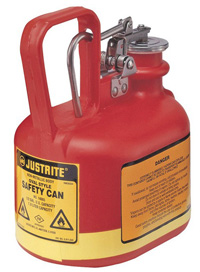



Find all of your laboratory and workplace safety supplies at Safety Emporium!
 Alcohol |
 Glossary Index |
 Alkali Metal |
| MSDS Topics |
Free Sites | FAQ's | Regulations | Glossary | Software | Suppliers |
| Books | Forum | Poll | Fun stuff | Quiz | Store | |
| Understand your MSDS with the MS-Demystifier | Search ALL our MSDS info | |||||
An aliphatic compound is a hydrocarbon (a molecule containing only carbon and hydrogen atoms) that is not aromatic; e.g. it lacks a particular arrangement of atoms in its molecular structure that would make it aromatic.
Aliphatic is especially used in reference to open-chain (non-cyclic) hydrocarbons. The term can also apply to open-chain hydrocarbon sub-units of larger organic molecules, for example "aliphatic group" or "aliphatic substituent".
The adjective can also be extended to other functional groups, for example "aliphatic amines" are amines in which only aliphatic groups are attached to the nitrogen atom of the amine. For example, trimethyl amine, N(CH3)3, which has three aliphatic CH3 substituents attached to the nitrogen atom, is an aliphatic amine, however N-N-dimethylaniline, N(CH3)2(C6H5), which has two CH3 groups and one phenyl group attached to the nitrogen atom, is not because the phenyl group, C6H5, is an aromatic substituent. Aliphatic alcohols and aliphatic ethers are additional common examples.
Some references define aliphatic with the term "linear hydrocarbon chains", but the term actually includes branched chains as well. Likewise, some definitions of aliphatic permit these chains to contain elements besides hydrogen and carbon. See our hydrocarbon entry more information about the various types of hydrocarbons and their nomenclature.
Aliphatic hydrocarbons are major components of everyday materials such as turpentine, gasoline and oil-based paints.

Store and dispense flammable liquids safely with flammable liquid safety cans from Safety Emporium.
Aliphatic hydrocarbons and their chemical derivatives are often quite flammable. While some pose no serious health risk, others, such as n-hexane are known neurotoxins. Most aliphatics can lead to defatting (drying) of the skin, which can possibly lead to dermatitis (eczema).
Always wear proper gloves and eye protection when working with aliphatic materials. Be sure to wear an appropriate respirator if ventilation is not adequate, and be careful to avoid ignition sources as the vapors can easily reach their flammable limit.
See also: hydrocarbon, aromatic, organic.
Further definitions from Google and OneLook.
Entry last updated: Saturday, February 19, 2022. This page is copyright 2000-2025 by ILPI. Unauthorized duplication or posting on other web sites is expressly prohibited. Send suggestions, comments, and new entry desires (include the URL if applicable) to us by email.
Disclaimer: The information contained herein is believed to be true and accurate, however ILPI makes no guarantees concerning the veracity of any statement. Use of any information on this page is at the reader's own risk. ILPI strongly encourages the reader to consult the appropriate local, state and federal agencies concerning the matters discussed herein.